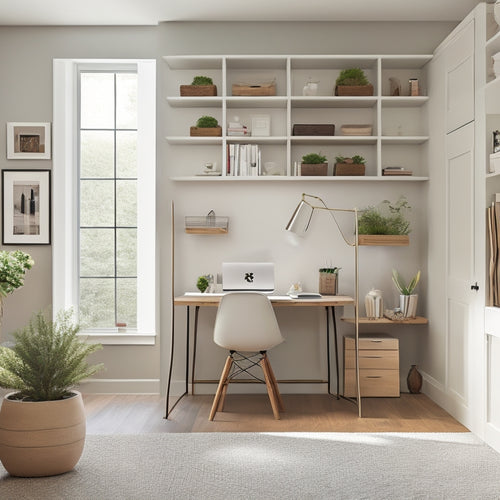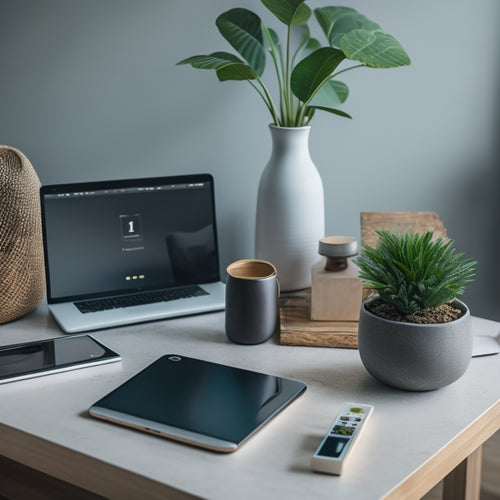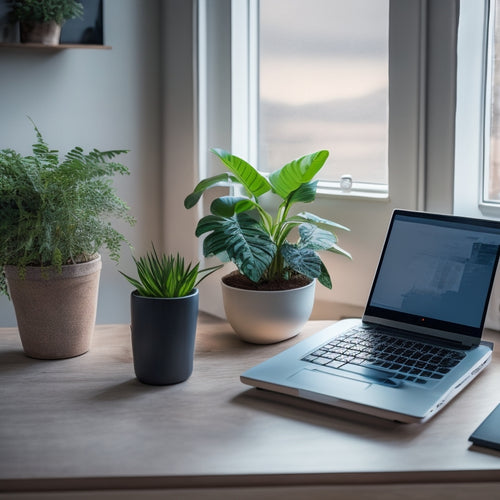
Organize Your Craft Room With Customized Storage Solutions
Share
You've got a craft room that's bursting with supplies, but chaos is taking over. It's time to create a customized storage solution that suits your unique needs and space. Start by measuring your room, evaluating the natural light, and identifying obstacles. Then, consider your storage needs and tailor a solution that maximizes your space. Use materials like wood, fabric, or containers to create a system that's both functional and visually appealing. With designated zones, labeling, and categorization, you'll be able to find what you need in a snap. As you tackle this project, you'll discover even more ways to optimize your space and unleash your creativity.
Key Takeaways
• Tailor storage solutions to specific craft supplies and needs to maximize space utilization and efficiency.
• Use materials like wood, fabric, or containers to create customized storage solutions that fit the craft room's unique needs.
• Ensure every item has a designated place to reduce stress, increase creativity, and facilitate easy access to supplies.
• Consider the room's size, obstacles, and natural light impact when planning the layout and storage solutions.
• Label and categorize craft supplies using a color-coded system, creative containers, and alphabetical sorting for easy access and maintenance.
Crafting Chaos to Calm Sanctuary
Transform your craft room from a cluttered, overwhelming space into a serene oasis by acknowledging the emotional attachment you have to your supplies and letting go of items that no longer serve you. It's time to let go of the guilt and shame associated with getting rid of items that no longer spark crafting inspiration. Recognize that holding onto them is preventing you from creating the peaceful environment you need to focus on your craft.
Start by gathering boxes and bags, and begin the decluttering process. Sort items into categories, and be honest with yourself - when was the last time you used that specific tool or material? If it's been over a year, it's probably safe to let it go. Consider donating gently used items or repurposing them into something new.
As you declutter, you'll start to feel a sense of relief and freedom. You'll be amazed at how a clutter-free space can spark new crafting inspiration and creativity. By letting go of the old, you're making room for the new and exciting projects that await you.
Measuring Your Craft Room Space
Now that you're ready to transform your craft room, measuring the space is crucial to achieve a functional and efficient layout.
You'll need to assess the room's size to determine the best placement of your craft stations, storage units, and supplies.
Assess the Room Size
You'll need to take precise measurements of your craft room's length, width, and any obstacles or features that could impact your organizational design. This will help you visualize your room layout and identify potential challenges. Measure the room from wall to wall, taking note of any windows, doors, or built-in shelves. Don't forget to measure the height of the ceiling, as this can affect your storage options.
Next, identify any obstacles, such as plumbing fixtures, electrical outlets, or heating vents, that may influence your storage design. Consider the location of any windows, as natural light can impact your crafting experience. Take note of any built-in features, like shelves or cabinets, that can be repurposed or incorporated into your organizational system.
With these measurements in hand, you'll be able to create a realistic room layout that accommodates your storage needs. By understanding the dimensions of your space, you can begin to envision how you'll utilize storage options, such as shelves, cabinets, or workstations, to create a functional and efficient craft room.
Identify Storage Needs
With your room's dimensions in mind, it's time to evaluate the types and quantities of craft supplies you need to store, as this will dictate the kind of storage solutions you'll require. Examining your supplies is essential in optimizing your layout.
Take stock of what you have, and categorize items into groups such as paper crafting, sewing, painting, and so on. This will help you identify what types of storage you need, such as shelves, bins, or drawers.
Consider the following factors to determine your storage needs:
-
Frequency of use: Store frequently used items in easy-to-access locations, and less frequently used items in harder-to-reach areas.
-
Supply size and shape: Consider the size and shape of your supplies when selecting storage solutions. For instance, large rolls of paper may require a vertical storage unit, while small beads may need a small, compartmentalized container.
-
Supply type and material: Different supplies require specific storage conditions. For instance, fabrics may need to be stored away from direct sunlight, while paints may need to be stored in a well-ventilated area.
Custom Storage for Unique Needs
Crafters often accumulate unique items that don't fit into standard storage solutions, requiring creative custom storage solutions to keep them organized and accessible. You might've a collection of vintage buttons, a stash of specialty yarns, or a set of unique painting tools that don't fit into traditional storage bins. This is where personalized organization comes in – by tailoring your storage solutions to your specific needs, you can guarantee that every item has a designated place.
You can create custom storage solutions using materials like wood, fabric, or repurposed containers. For instance, you can build a wooden shelf with compartments specifically designed to hold your buttons or yarns. Alternatively, you can use fabric bins with custom labels to store your painting supplies.
Maximizing Vertical Storage Potential
Many craft rooms have limited floor space, but maximizing vertical storage potential can greatly increase your storage capacity and keep your workspace clutter-free. By utilizing wall space, you can create a more organized and efficient craft room.
Here are a few ideas to get you started:
-
Install shelves: Creative shelving can help you store items like baskets, bins, and containers, keeping them off the floor and out of the way.
-
Use hanging organizers: Hanging organizers, such as pegboards or hooks, can hold items like scissors, tape, and other frequently used supplies.
-
Add a storage ladder: A storage ladder can provide additional shelf space for storing items like books, fabric, or paper, and can also serve as a convenient workspace.
Labeling and Categorizing Essentials
You'll be amazed at how much simpler it is to find what you need when you label and classify your craft supplies, making it an essential step in maintaining an organized craft room.
A well-labeled system helps you quickly identify what's inside containers, saving you time and reducing frustration.
Implement a color-coded organization system, where similar items are grouped together and assigned a specific color. This visual cue will help you locate items instantly.
Use creative containers with clear labels to store supplies. For example, label a bin 'Paints' and categorize them by type, such as acrylic, watercolor, or oil.
You can also use alphabetical sorting to arrange supplies, like adhesives, brushes, and canvases.
Create themed sections, like a 'Paper Crafting' area or a 'Sewing Station,' to keep related supplies together. This structured approach guarantees that everything has a designated home, making it easier to maintain your organized craft room.
Functional Zones for Efficiency
Now that your supplies are labeled and categorized, it's time to create functional zones within your craft room to maximize efficiency and workflow. This means designing areas that serve specific purposes, making it easy to find what you need when you need it. By doing so, you'll optimize your storage placement and workflow, saving you time and energy.
Here are three ideas to get you started:
-
Workstation Zone: Designate a specific area for your main crafting projects, keeping essential tools and supplies within arm's reach.
-
Supply Hub: Create a central storage area for your labeled and categorized supplies, making it easy to restock your workstation zone as needed.
-
Inspiration Station: Set up a zone for brainstorming and idea generation, complete with inspirational materials, sketches, and notes.
Maintaining Organization Over Time
As you settle into your newly organized craft room, set a maintenance routine to sustain your space clutter-free and functional over time. This is essential to make sure that your hard work doesn't go to waste.
Allocate a specific time each week, say 30 minutes, to tidy up and maintain your space. This time management technique will help you stay on top of clutter and keep your room organized.
During this maintenance session, go through each zone and declutter any unnecessary items. Remove any scraps, broken materials, or items that no longer serve a purpose.
Decluttering tips include sorting items into categories, getting rid of duplicates, and donating or recycling items that are still in good condition. By doing so, you'll prevent clutter from building up and keep your space functional.
Frequently Asked Questions
How Do I Prioritize Storage Needs for Multiple Crafts and Hobbies?
You identify your most-used crafts and hobbies, then assess your craft room layout to determine best storage zones. Next, prioritize storage needs by categorizing supplies and allocating space for each activity, ensuring efficient storage organization.
Can I Customize Storage Solutions on a Limited Budget?
Can you really afford not to customize your storage solutions? You can create DIY solutions on a limited budget by repurposing furniture, like turning an old bookshelf into a supply station, to maximize storage and minimize costs.
What Are the Benefits of Using Clear Storage Containers?
You'll love using clear storage containers because they allow you to maximize visibility, reducing clutter and making it easy to find what you need, plus they help you see when supplies are running low.
How Often Should I Reassess and Adjust My Storage System?
Imagine your storage system as a messy closet - it's time to crack open the door and confront the chaos! You should reassess and adjust it regularly, ensuring efficiency, to avoid drowning in a sea of supplies and scraps.
Are There Any Eco-Friendly Storage Solution Options Available?
You're looking for eco-friendly storage solutions, and you'll be happy to know that sustainable options abound! Consider upcycled materials, repurposed containers, and recycled fabric bins to create a storage system that's gentle on the planet.
Related Posts
-

Optimize Your Small Home Office With Smart Storage
You can instantly boost your productivity and reduce stress by optimizing your small home office with smart storage s...
-

Top Digital Tools for Home Decor Organization
You're looking to take your home decor organization to the next level with the right digital tools. From cloud storag...
-

Declutter Your Desk With These Online Tutorials
You're just one organized desk away from boosting your productivity, reducing stress, and achieving a sense of contro...


